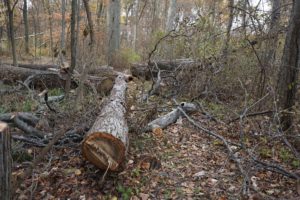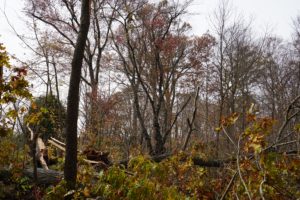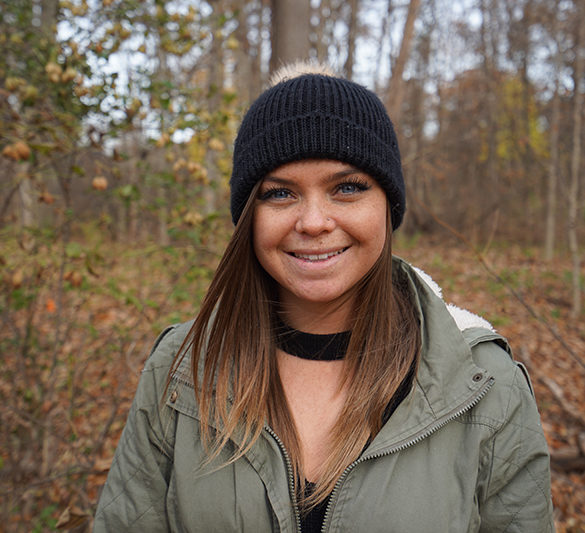When Josie Weaver was a student at Ball State, walking through Christy Woods gave her a sense of peace, reminding her why she chose to major in natural resources.
7:30 a.m.
Sharyl Grant unlocks the metal gates surrounding Christy Woods in a pattern. She starts with the south entrance by Ball State University’s Rinard Orchid Greenhouse, then moves clockwise, ending with the gates on the east side of the woods.
It was the morning of November 6, 2017. As she crossed the Prairie—the small, grassy section nestled in the middle of the woods—Grant noticed several trees had snapped in half from the winds of the previous night’s storm. This was the first tornado to cause so much damage since Grant started working as the manager of Christy Woods in 2001. The EF-1 tornado struck 14 trees, causing some to fall or lose their crowns.
After noticing the broken trees, Grant saw more damage. She saw tree limbs thrown across dirt paths. She saw the short, splintered trunks of once-tall oaks. Looking up, she saw limbs hovering above her head.
She turned back to the south entrance and locked the gate. Christy Woods couldn’t have visitors that day.

8:04 a.m.
Prairie
Grant spends most mornings working in the greenhouses. She grows plants for classes and herbs for campus dining. She knows the purpose of Christy Woods, which sees more than 100 visitors every day, is to be used as an outdoor classroom. She tries her best to make sure it stays that way.
Christy Woods is part of the original land plot the Ball brothers donated to the state of Indiana for the foundation of Ball State. As the university celebrates its 100th birthday, so does Christy Woods.
A century ago, livestock grazed through the grass in the woods. Dr. Otto Christy, head of the Ball State science department at the time, soon realized that this was detrimental to the land because native plants and wildlife weren’t able to grow there. He worked with a group of biology students to restore the land so it could represent what a native Indiana forest would be, Grant says.
Christy Woods doesn’t close often. Grant used to keep the gates locked if there was a wind advisory, but any trees that may have fallen from wind are no longer standing. Grant has only had to close Christy Woods for an extended time once before. In 2005, an ice storm hit Muncie, and the woods were closed for one month.
Grant says the storm affected everything, changing the shape of trees and freezing animal habitats. The maintenance staff of the woods, which includes Grant, student employees, and other staff, are the main ones who work on upkeep. The University Grounds personnel help when needed, which is appreciated by Grant and the rest of the staff. After the ice storm, they couldn’t begin cleaning up the woods until a week later, when everything had melted.
Closing the gates on Monday morning, Grant knew the maintenance after the tornado would be an ongoing process. Christy Woods couldn’t serve its purpose as an outdoor classroom until it was safe.
9:32 a.m.
East Woods
Josie Weaver left home early to walk through the woods. She parked her car in a commuter lot and started to take her usual path to class. But when she reached the woods’ metal gate, it was locked.
On a normal day, Weaver walked a short gravel path through the East Woods. She was a senior natural resource environmental management major, and that was the first day she had ever seen the woods closed.
When Christy Woods was open, Weaver would arrive on campus 30 minutes before her class, just to spend a little time in nature. Walking through the woods made her morning a little better. Spending time alone in nature helps remind her why she chose a major in natural resources.
Weaver spent about one hour in Christy Woods every week. On the short walk through the East Woods, she would often stop and take pictures of things that caught her eye. When Weaver walked through Christy Woods in August, she liked to look up at the canopy of leaves above her. Later in the semester, she looked down at the leaves beneath her feet.
Weaver likes to use all her senses when she spends time in nature. “I never wear my headphones when I walk through here,” she says. “I want to hear the birds and animals.”
12:17 p.m.
West Woods
Christy Woods was Weaver’s outdoor classroom. There, she learned how to test soil, water, and air quality. Her favorite class was about outdoor interpretation and taught by Amy Gregg.
Gregg, chairwoman of the department of natural resources and environmental management at Ball State, During Weaver’s junior year, she took the outdoor interpretation class to the West Woods. “I want everyone to draw what they see,” Gregg told the class.

Weaver drew a tree—her favorite tree in Christy Woods. Its trunk split at the base and its branches stretched upward, easily mistaken for individual trees themselves. The bark was almost black, and burls covered every branch. Weaver thought the tree might be diseased, but it stood out as her favorite.
Gregg also taught her interpretation class to give tours of natural areas. Students learned how to arrange a group of people if they wanted to direct attention to a certain tree or animal.
Gregg can’t imagine what teaching would be like without Christy Woods. To her, teaching students about nature doesn’t make any sense if the class can’t spend time outside. When Christy Woods closed after the tornado, students lost the outdoor experience for more than a week.
2:30 p.m.
East Woods
Christy Woods was closed for three days. After the woods re-opened, Weaver couldn’t wait to resume her walks before and after class. She missed spending time in nature and clearing her mind for the day.
Weaver believes that if more students came to Christy Woods, it might help them cope with the stress of being in college. “I just think that the natural environment and being outside is so beneficial to everyone’s mental and emotional health,” she says. “Anyone can come out here. Anyone.”
After taking classes in Christy Woods, Weaver realized the specific career path she wants to follow: teaching children about nature and the environment. She wants to bring people to natural areas and let them experience the outdoors the way she did with Gregg’s interpretation class. After having class in Christy Woods, she understands that everyone’s relationship with nature is different. She knows some people might like the prairie for its grass and flowers, and others might like the East Woods for its tall trees and gravel trails.
Weaver wants to help people make connections with nature. Christy Woods reminded her why nature and the environment are so important and why she wants people to have an appreciation for them.
Today, she works for employee recreation at Yellowstone National Park. She leads tours around the space, teaching guests about Yellowstone. She gets to spend more time outside than she did in college, whether it’s to stargaze, backpack, or watch wildlife.
“If people care about nature, and they take that through their lives,” she says, “I don’t know. Maybe we would have a better world.”
Corrections to this story have been made. The story originally read that the woods was once a prairie, which it was not. The story also now reads that the University Grounds personnel help when needed.




